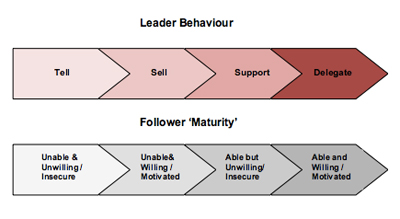On Friday, we looked at the importance of having flexibility in your leadership style. In today’s post we discuss how to choose which style and when.
Your decision about how to choose which leadership style depends on two factors:
The Situation
The more urgent, dangerous or critical the situation, the more you should veer towards the ‘command and control’ end of the continuum. Don’t try to engage everyone’s inspired motivation and commitment if the house is on fire: bark orders!
As a leader in these situations you are expected to take control. Provide clear direction and, if necessary, instructions, to get the job done.
The ‘Maturity’ of the ‘Follower
We don’t mean here their age, qualifications or length of service. What we mean is simply their willingness and their ability to carry out the specific task at hand.
If a person is unwilling, they are resistant to doing the task for whatever reason, and if they are unable to do the task, they lack the necessary skill set. The more unable and unwilling they are, the more your style should move to the left-hand ‘command and control’ end of the continuum.
This gives you a guide as to how to match your leadership style to the ‘maturity’ of your ‘follower’ – start where they are:
Judge willingness and ability (‘maturity’) against the specific task, and match your leadership style to this. You will make mistakes if you judge a person according to their willingness and ability in a different task, or a completely different role – see some examples below.
Hence your puzzlement when an apparently perfectly capable person suddenly seems unwilling to take on a new task, or needs ‘hand-holding’ in a way you are not used to. If you think carefully, you will find that however capable the person has seemed in the past, it was in another role, or on a different task.
The most important quality of leadership is the ability to choose, then show, flexible leadership style depending on the task maturity of the person you are leading. This is often the key leadership skill participants learn and go on to demonstrate in our Communication for Effective Leadership Programme. You need to be willing and able to ‘flex’ your leadership style, even adopting styles that may initially be unnatural or uncomfortable for you.
The good news is that if you match your style to a person’s current task-specific needs, they will very quickly grow and learn, allowing you to return to a more ‘hands-off’ mode. You very quickly improve your ability to get work done through your team, and develop individuals through to full ability and willingness – full ‘maturity’ – in their roles.
Here are a couple of real life examples which showcase the need for a flexibility in leadership style:
- An extremely capable purchasing manager was moved into a wider role within the purchasing function, responsible for managing staff, a new task for her. Her manager had come to trust that he could simply delegate to her, providing occasional support and reviews. He could not understand why she was now so unconfident and needed so much more input from him; he was still managing her by delegating the whole job to her. However, in some aspects of her job, she had shifted to a state of under-confidence and insecurity and needed to be walked through these aspects until her ability and confidence levels improved. The mismatch caused huge discomfort for both until they realised what was happening.
- A very successful sales person moved for his career development into his first ever marketing role. His managers assumed he would naturally absorb the skills of the new role and carry it out as successfully as he had his sales role, but he immediately began to struggle. Again, his ‘maturity’ level had reverted temporarily to insecurity and lack of ability, while his managers were continuing to manage him as they had done in his previous role where he was fully ‘mature’ in every aspect of the job. He suffered a huge knock to his confidence and self-esteem before he was given the support he needed.
The theory we’ve talked about here is adapted from Hersey and Blanchard’s Situational Leadership model. Hersey’s book, The Situational Leader, will give you more detail on how it works.

